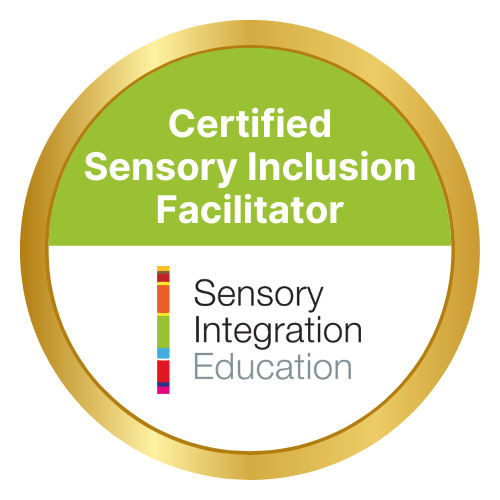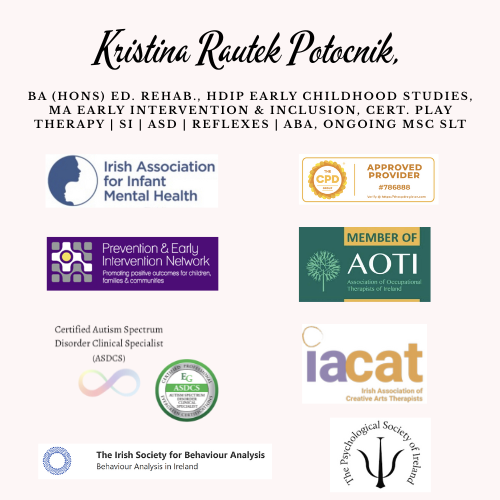Understanding Sensory Integration in Early Childhood

Author: Kristina Rautek Potocnik, BA (Hons) Ed. Rehab., HDip Early Childhood Studies, MA Early Intervention & Inclusion, Cert. Play Therapy | SI | ASD | Reflexes | ABA, ongoing MSc SLT
Sensory integration begins before birth and continues after the child is born. It helps babies and young children learn how to crawl, play, and interact with their surroundings. Between the ages of three and seven, children develop better control of their senses and movements. During this time, they also begin to respond more to social and thinking tasks while still learning through play.
Although we often think of the senses separately, they work together to help us understand our world and how we fit in it. Children use their senses to explore, focus, move, and feel safe. Sensory development supports everything from balance and coordination to emotions and learning.
There are eight senses that work as a team. The sense of balance, called the vestibular system, is found inside the ear. It helps children know how fast they are moving, which direction they are going, and where their body is in space. It helps the body stay upright and steady, and it also affects how alert or calm a child feels.
The sense of body position, known as proprioception, comes from signals in the joints and muscles. It tells the brain where body parts are without having to look. This helps with posture, movement control, and body awareness.
Touch is one of the first senses to develop. It helps a child feel textures, pressure, and temperature. Touch also helps the brain build a clear body map and protects the body by helping a child respond to pain or uncomfortable sensations.
Sight gives children important information about what is around them. It supports planning, coordination, and balance. Children need good eye focus, smooth eye movement, and visual memory to learn new tasks like reading or catching a ball.
Hearing helps children listen, understand, and respond to sounds. It plays a big part in learning language and communicating with others.
Smell gives strong messages to the brain. It can remind a child of people or places and can cause either a happy or unpleasant reaction.
Taste helps children tell the difference between sweet, salty, sour, and bitter. It also gives clues about food texture and safety.
There is also an internal sense that tells the brain how the body feels inside. This helps a child know when they are hungry, tired, or need the toilet.
Sometimes, the brain has trouble handling all the sensory signals. This is called sensory integration difficulty. A child may react too strongly or not strongly enough to things like sound, touch, or movement. For example, a child might cry when rocked or become upset by normal sounds or bright lights.
If parents notice these signs, they can speak to a sensory integration and/or early intervention specialist. The specialist will observe the child during daily routines like feeding, changing, and playing. They will also talk to the parents about how the child behaves at home and in other settings. Based on this, the therapist and parents can make a plan together.
The goal is to help the child take part in daily life with more comfort and success. The specialist might suggest playful activities that match the child’s needs and support learning through movement and touch. They also guide parents on how to adjust routines and home spaces to make them more supportive.
Sensory development is a key part of a child’s early years. With the right support and a playful, rich environment, every child can learn to use their senses in a healthy and balanced way.
Latest Posts
- How children make sense of the world through their senses
- How your baby learns about the world through their senses
- Helping your child grow stronger through movement and play
- Understanding How Early Intervention Helps Children Learn, Move, and Connect
- How to Recognise Tactile Defensiveness and Help Your Child Feel Safe
- Understanding Feeding Challenges and How to Support Your Child at Home
- Let’s Talk Sitting: Exploring Floor Seating Options
- Retained Primitive Reflexes: The Hidden Cause Behind Developmental Struggles
- Where Curiosity Blossoms: How Children's Play Nurtures Growth for All
- Helping Your Child Through Stress: A Gentle Guide for Parents
- Sweet Little Lies – How to Recognise and Respond with Care
- Chores Are More Than Just Tasks – They’re a Tool for Growing Independence, Focus, and Confidence
- How to Help Children Develop Emotional Intelligence
- Blending Technology and Care: How VR Meta Quest Supports Children at NeuroNest
- A simple guide for parents who want to raise confident, happy children
- Setting Boundaries with Love: A Simple 3-Step Guide for Parents
- Understanding Behavior Through the Nervous System
- A Compassionate Lens on Dysregulation in Non-Speaking Autistic Individuals
- Supporting Development Through Movement: The Role of the Swing in Early Intervention
- Blending Tradition and Innovation: How NeuroNest Supports Your Child’s Unique Journey
- When Movement Meets Innovation: Supporting Child Development with GoBalance
- Why Visual Perception Matters for Everyday Life and Development
- Benefits of Chess in Early Intervention
- Building Healthy Nutrition from the Start
- A Journey Back to Your True Self
- Supporting Your Child’s Hand Skills for Confident Writing
- Blending the Best of Both Worlds
- Helping Toddlers Eat Well: A Parent’s Guide
- Why Tummy Time Matters for Your Baby's Development
- Helping Your Child Build Everyday Independence
- Who Are the Disconnected Kids?
- From First Tries to Automatic Habits: Understanding the Stages of Skill Learning
- Why a Child’s Level of Alertness Matters for Memory and Learning
- Early brain development starts before birth
- Why Slowing Down, Adapting Tasks, and Adding Breaks Helps Children Learn Better
- Why ADHD, Autism, Dyslexia and Other Challenges Need a New Approach
- The surprising power of copying in child development
- Books are more than just language tools—they’re powerful allies in sensory and motor development.
- Rethinking sensory support: moving beyond expensive rooms toward everyday understanding.
- Understanding how fear develops in a child’s brain
- Understanding how an early baby reflex can affect your child’s daily life
- A gentle start into baby development through movement and bonding
- A child-centred, research-informed approach that uses the power of play to support communication, emotional regulation, motor development, and meaningful growth from infancy to twelve years.
Our Partners




Our Memberships


